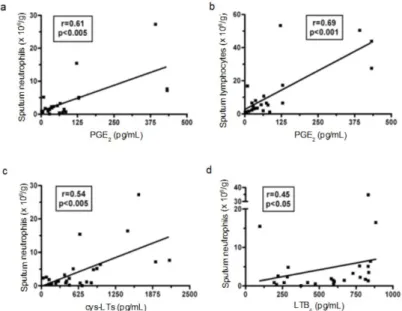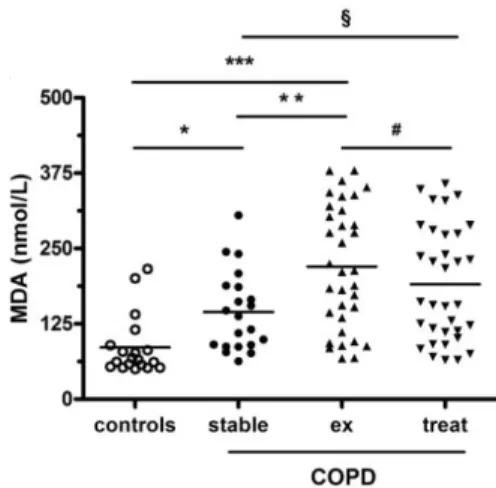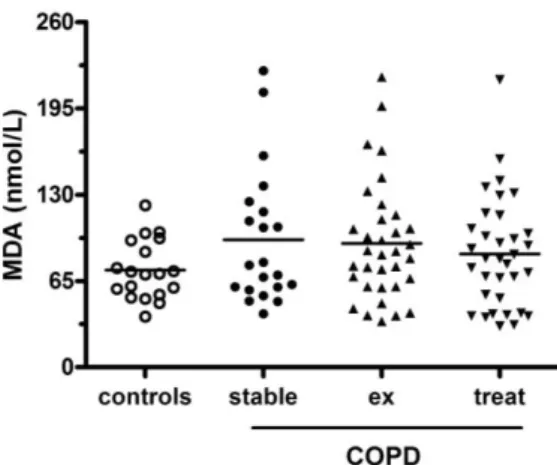Assessment of eicosanoids and oxidative stress markers in chronic obstructive
pulmonary disease
Doctoral thesis
Orsolya Tünde Drozdovszky
Semmelweis University Doctoral School of Clinical Medicine
Supervisor: Balázs Antus, MD, DSc
Official reviewers: Zsolt Komlósi, MD, PhD Zoltán Balikó, MD, PhD
Head of the final examination committee: Veronika Müller, MD, PhD Members of the final examination committe: Anikó Bohács, MD, PhD
Éva Vízi, MD, PhD
Budapest 2016
1
1. INTRODUCTION
Chronic obstructive pulmonary disease (COPD) ranks fourth among the causes of mortality throughout the world, and it is expected to rank third by 2020. There are several inflammatory mediators that are involved in COPD, and there is overwhelming evidence that oxidative stress plays also an important role in development of COPD. Although the role of lipid mediators in the pathophysiology of COPD is incompletely understood, several lines of evidence indicate that lipid mediators, like prostaglandins and leukotrienes as well as lipid peroxidation products including malondialdehyde (MDA) are involved in the recruitment of inflammatory cells in the airways and the regulation of the vascular and bronchial tone.
COPD is a heterogeneous disease, and there is much interest in the use of biomarkers that can define specific disease subgroups with different long-term prognoses or responses to therapeutic intervention. The identification of an inflammatory profile with a non-invasive method and the exploration of other biomarkers might contribute to a better understanding of its complex pathophysiology.
In general, lipid mediators and oxidative stress markers can be measured invasively and non-invasively. Most of the studies investigating the role of eicosanoids in COPD have used invasive techniques such as bronchoalveolar lavage (BAL). In this case repeated measurements are not possible and the method cannot be routinely used in patients with severe disease or in children. Sputum induction or exhaled breath condensate (EBC) collection are safe non-invasive techniques that have been increasingly used for the assessment of airway inflammation in patients with obstructive airway diseases. Until recently, most studies had used EBC as a type of respiratory sample to profile eicosanoids in COPD. However, measurement of putative mediators in EBC usually has poor reproducibility. Assessment of eicosanoids in the sputum supernatant is a more reliable approach to study the underlying pathophysiology and to identify pulmonary biomarkers of potential clinical utility in the management of the disease.
Acute exacerbations of COPD (AECOPD) are associated with increased inflammation and mediator release into the airways. Among mediators involved in the
2
development of AECOPD, arachidonic acid (AA) metabolites such as prostaglandin E2 (PGE2), leukotriene B4 (LTB4) and 8-isoprostane may play an important role.
AECOPD are associated with disease progression, higher healthcare cost, and increased mortality. The value of adding biomarkers to clinical variables to predict exacerbations remains unproven.
Accordingly, the aims of these studies were, first, to compare eicosanoids in invasive and non-invasive airway fluids, and second, to determine changes in levels of eicosanoids, 8-isoprostane and MDA in patients hospitalized with AECOPD and after their treatment. Additionally, we investigated the relationships between these inflammatory markers and clinical variables. We hypothesized that these mediators may play a pathophysiological role in development of AECOPD, and that the measurement of these markers provides a useful non-invasive approach to study inflammation in the airways during exacerbations.
2. OBJECTIVES
The main objectives of the research presented in my thesis were as follows:
1. Comparison of invasive and non-invasive sampling techniques for the assessment of different eicosanoids in the airways.
2. Assessment of LTB4, 8-isoprostane, PGE2 and cysteinyl-leukotrienes (cys-LTs) in sputum of patients with COPD at the onset of an exacerbation and during the course of recovery.
3. Assessment of oxidative stress in the airways of patients with COPD using MDA.
3. METHODS
First study
Study subjects and study design
25 stable ex-smoker COPD patients (GOLD II-III; age >40 years) participated in the cross-sectional study. All patients were clinically stable and were not treated with oral
3
corticosteroids and antibiotics for at least 2 month. They refrained from smoking for at least 6 months. In the first visit induced sputum samples and EBC were collected from patients, and levels of fractional exhaled nitric oxide (FENO), blood gases and lung function parameters were measured. In the second visit patients were subjected to bronchoscopy to collect BAL.
Lung function test
Lung function was determined by electric spirometer (Medicor, MS-11, Piston Ltd., Budapest, Hungary).
FENO measurement
FENO was measured with a chemiluminescence analyzator (Model LR2500, Logan Research, Rochester, UK) at a constant flow of 50 mL/s according to American Thoracic Society/European Respiratory Society guidelines.
Bronchoscopy
A BAL sampling was performed with a flexible endoscope according to international standards.
EBC collection
EBC was collected for a period of 10 min using an EcoScreen condenser (Jaeger, Hoechberg, Germany).
Sputum induction and processing
In stable COPD patients sputum was induced by the inhalation of hypertonic saline solution (4% sodium chloride) delivered by an ultrasonic nebulizer (Ultra-Neb 2000, DeVilbiss Healthcare Ltd., Tipton, UK). Spontaneous and induced sputum samples were processed similarly within 120 min. Citospin slides were painted with May- Grünwald-Giemsa solution. At least 400 inflammatory cells were counted at each cytospin slide. The inflammatory cells in sputum were shown as a percentage of total non-squamous cells.
4
Enzyme immunoassays
LTB4, 8-isoprostane, cys-LTs and a stable derivative of PGE2 were determined in sputum supernatants by enzyme immunoassays (EIA, Cayman Chemical, Ann Arbor, MI, USA) according to the manufacturer’s protocol, with the modification that dithiothreitol (DTT) of the same concentration as in the sputum supernatant (0.04%) was added to the standards in agreement with other studies.
Repeatability of EIA measurements
The repeatability of EIA measurements in the sputum was determined in a pilot study.
Sputum samples collected from a subset of COPD patients (n=6) were divided into two aliquots, which were then analyzed separately.
Second study
Participants and study design
37 ex-smoker patients hospitalized with AECOPD were recruited for the study. All patients were >40 years of age and had smoking history of >10 pack-years and documented airway obstruction with forced expiratory volume in one second (FEV1)
<80% of predicted and post-bronchodilator FEV1/forced vital capacity (FVC) <0.7.
Additionally, 25 clinically stable ex-smoker COPD patients were enrolled in the study.
In patients with AECOPD, spontaneously expectorated sputum were collected and levels of FENO, blood gases and lung function parameters were measured at two time points: first at hospital admission, and again on the day of discharge after hospital treatment. From stable patients induced sputum samples were obtained.
Lung function test, FENO measurement, sputum collection and processing, and eicosanoid measurements
All these measurements were performed as described before in first study.
5
Comparison of spontaneous and induced sputum
To compare eicosanoid levels in induced and spontaneous sputum, a subgroup of stable COPD patients (n=8) capable to expectorate sputum spontaneously was selected. From these subjects both induced and spontaneous sputum samples were collected.
Third study
Participants and study design
34 ex-smoker patients hospitalized with AECOPD were recruited for the study.
Additionally, 21 clinically stable ex-smoker COPD patients and 20 healthy non- smoker controls were enrolled in the study. Study protocol was the same as described in the second study.
Lung function test, FENO measurement, sputum and EBC collection and sputum processing
All these measurements were performed as described before in first study.
Measurement of MDA in EBC and sputum
MDA concentrations in EBC and sputum supernatant were measured with isocratic high-performance liquid chromatography (HPLC) system (Jasco FP2020 Plus;
ABL&E-Jasco Ltd.; Budapest, Hungary) using MDA reagent kit (Chromsystems Ltd.; Munich, Germany) according to the method established in our laboratory. The intra- and inter-assay repeatability and the between-day variability of MDA measurements were also assessed.
Comparison of spontaneous and induced sputum
In order to compare MDA levels in induced and spontaneous sputum, a subgroup of stable COPD patients (n = 10) capable of expectorating sputum spontaneously were selected in a pilot study.
6
Statistical analysis in the first, second and third studies
Data are presented as meanSEM or median with interquartile ranges when appropriate. Data were analyzed by the Student’s- t-test, Wilcoxon signed-rank test, Mann-Whitney or Newman-Keuls test. Correlation coefficients were calculated by the Pearson’s or Spearman’s methods. Predictive values were calculated by the Receiver Operating Characteristic curve analysis. The repeatability and variability of the measurements were assessed using the CV and the Bland-Altman test.
Calculations were performed by GraphPad Prism 4.0 (GraphPad Software Inc., San Diego, CA, USA). A p value <0.05 was considered significant.
4. RESULTS
First study
Comparison of eicosanoids in sputum, BAL and EBC
Concentrations of cys-LTs were significantly higher in sputum (211.9 [128.6-827.1]
pg/mL) compared to BAL (122.5 [60.4-256.1] pg/mL, p<0.05) or EBC (33.8 [19.9- 58.1] pg/mL p<0.01; Figure 1). 8-isoprostane and LTB4 levels were also higher in sputum compared to BAL (8-isoprostane: 29.7 [13.8-60.8] vs. 22.0 [12.7-57.7]
pg/mL, p=NS; LTB4: 276.1 (105.4-594.7] vs. 27.5 [10.7-84.3] pg/mL, p<0.01). In EBC these mediators were only sporadically detected. Similarly, PGE2 was detectable only in sputum and BAL. PGE2 was higher in Bal compared to sputum but the differentiation was not statistically significant (3,0 [0,8-14,6] vs. 11,3 [7,1-18,3], p>0,05).
7
Köpet BAL EBC
0 500 1000 1000
4000 **
*
det.limit: 20 pg/mL
a
cisz-LT (pg/mL)
Köpet BAL EBC
0 200 400 600
**
*
det.limit: 2,7 pg/mL
c
8-izoprosztán (pg/mL)
Köpet BAL EBC
0 250 500 750 1000
#
det.limit: 13 pg/mL
b
LTB4 (pg/mL)
Köpet BAL EBC
0 10 20 30 40
det.limit: 2 pg/mL
d
PGE2 (pg/mL)
Figure 1. Concentrations of eicosanoids in sputum, bronchoalveolaris lavage (BAL) and exhaled breath condensate (EBC). *p<0,05 EBC vs. BAL, **p<0,001 EBC vs. sputum, #p<0,05
BAL vs. sputum Reproducibility of the measurements of eicosanoids
The mean coefficients of variation (CV) for intra- and inter-assay repeatability were 15.4 and 20.8%, respectively.
Correlations
We found significant correlations between the number of neutrophils and the levels of cys-LTs, LTB4 and 8-isoprostane in sputum (Figure 2). Lipid mediator levels in BAL and EBC did not correlate with sputum neutrophil counts. Measuring the same mediator from different airway samples, we noted a significant relationship between sputum and BAL cys-LT levels.
8
Figure 2. Correlation between the number of sputum neutrophils and levels of eicosanoids in sputum (a-c) or between sputum and BAL cysteinyl-leukotriene (cys-LT) levels (d).
Second study
Concentration of LTB4, cys-LTs, PGE2 and 8-isoprostane at the time of AECOPD and after hospital treatment
Levels of 8-isoprostane were significantly higher in exacerbated patients compared to stable subjects (89.5 [36.9-184.7] vs. 29.7 [13.8-68.8] pg/mL, p<0.01) and remained elevated after treatment of exacerbation (84.1 [34.1-185.3] pg/mL, p>0.05; Figure 3).
9
Figure 3. Sputum eicosanoid concentrations in stable COPD patients (stable) and in COPD patients hospitalized at the time of an acute exacerbation (Ex) and after hospital treatment (Treat). *p<0.05, **p<0.01 and ***p<0.001 exacerbation vs. stable COPD, #p<0,01 exacerbation
vs. after treatment
Cys-LTs levels were slightly higher in patients with exacerbations, however, differences did not reach statistical significance (211.9 [128.6-827.1] vs. 469.9 [169.2-906.8] pg/mL, p=NS). Treatment had no effect on cys-LTs concentrations (324.2 [114.3-698.1] pg/mL, p=NS).
PGE2 concentrations were significantly higher in exacerbated patients than in stable subjects (39.8 [13.3-103.3] vs. 3.82 [1.77-6.63] pg/mL, p<0.001) and levels significantly decreased along with treatment (19.6 [4.6-52.5] pg/mL, p<0.01).
Levels of LTB4 were increased in patients with exacerbation compared to stable subjects (587.7 [252.9-774.8] vs. 276.1 [105.4-594.7] pg/mL, p<0.05). However, treatment had no effect on LTB4 concentrations (661.5 [182.6-758.1] pg/mL, p=NS) by the time of discharge.
10
Comparison of the levels of eicosanoids in spontaneous and induced sputum There were no differentation between the level of eicosaooids of spontaneous and induced sputum (p<0,05), although there was a strong significant correlation between the eicosanoid levels of the two samples (r>0,72, p<0,05).
Correlations
In patients with AECOPD significant correlations were observed between sputum PGE2 levels and sputum neutrophil and lymphocyte cell counts (Figure 4). Similarly, LTB4 and cys-LTs levels presented an association with the number of neutrophils in the sputum. Other sputum cell types, spirometric and other clinical variables showed no correlations with lipid mediator levels.
Figure 4. Correlations between the levels of eicosanoids and the neutrophil and lymphocyte cell counts in sputum of patients with AECOPD
11
Third study
Comparison of the levels of eicosanoids in spontaneous and induced sputum There were not any differentation between the MDA levels of spontaneus expectorated and induced sputum (p>0,05).
MDA in sputum
MDA levels in sputum were higher in stable COPD patients than in healthy controls (144.614.3 nmol/L vs. 85.911.3 nmol/L, p<0.05; Figure 5). In patients with AECOPD, sputum MDA concentrations were further increased (220.017.5 nmol/L, p<0.01) compared with stable COPD patients. MDA levels significantly decreased with treatment (190.76.3 nmol/L; p<0.05).
Figure 5. Malondialdehyde (MDA) concentrations in the sputum of stable COPD patients and AECOPD patients at the time of acute exacerbation (ex) and after treatment (treat).
*p<0.05 and ***p<0.001 stable COPD vs. healthy controls, **p<0.01 exacerbation vs. stable COPD, #p<0.05 treated vs. exacerbation, §p<0.05 treated vs. stable COPD
MDA levels in EBC
EBC MDA concentrations in controls (73.1±5.1 nmol/L), stable COPD patients (96.1±11.6 nmol/L) and patients with AECOPD (93.3±7.6 nmol/L) were similar (p>0.05) and treatment had no effect on EBC MDA levels either (85.3±7.1 nmol/L, p>0.05; Figure 6).
12
Intra- and inter-assay repeatability and between-day variability of MDA measurements
MDA levels in sputum or EBC did not change after the processed samples had been kept at 4°C for 2 weeks (intra-assay repeatability) (p>0.05). MDA concentrations in the two aliquots of the same sputum and EBC sample (inter-assay variability) were similar (p>0.05). Likewise, the mean CV for repeated measurements and the limits of agreement were comparable between sputum and EBC (p>0.05). With regard to between-day variability, sputum MDA levels measured in samples collected on two consecutive days from the same patients were similar (p>0.05). Although EBC MDA levels at the two assessment points were also comparable (p>0.05), the mean difference between the measurements increased up to 30.9 nmol/L. Moreover, the mean CV for repeated measurements was significantly higher (24.3 vs. 9.3%, p<0.05) and the limits of agreement markedly greater in EBC as compared with sputum.
Figure 6. Concentrations of malondialdehyde (MDA) in the sputum of stable COPD patients and AECOPD patients at the time of acute exacerbation (ex) and after treatment
(treat)
Association between ∆FEV1 and MDA concentrations
To further explore the changes in MDA levels among patients with AECOPD, subjects were stratified by tertiles for increases in FEV1 (FEV1 and FEV1 % of predicted) post-treatment. Patients in the highest and middle tertiles had sputum
13
MDA levels that were significantly decreased at discharge compared with those at admission (p<0.05). By contrast, MDA concentrations did not change during treatment (p>0.05) in patients in the lowest tertile.
Correlations between MDA and other variables
No significant correlations were observed between sputum or EBC MDA values and FENO, lung function, blood gas parameters or sputum total and differential cell counts measured either in stable disease or at exacerbation.
5. CONCLUSIONS
1. Eicosanoids were detectable in the sputum as well as the BAL, while in EBC only 8-isorpstane and cys-LT could be reliably measured. Levels of eicosanoids (except PGE2) were the highest in sputum and lowest in EBC.
2. The number of neutrophils in the sputum was related with levels of cys-LTs, LTB4, 8-isoprostane in the sputum indicating a role of eicosanoid measurements in the assessment of airway inflammation in stable COPD patients.
3. We found elevated PGE2, LTB4 and 8-isoprostane levels in the sputum of patients with AECOPD in relation with increased airway inflammation in these patients.
Among these mediators only PGE2 decreased along with clinical recovery that raises the possibility that PGE2 could serve as a useful biomarker of the process.
4. Levels of MDA in the sputum were increased in stable COPD patients compared with healthy controls indicating enhanced oxidative stress in COPD.
5. Sputum MDA levels were further increased in AECOPD, while treatment of exacerbation led to a decrease in sputum MDA. This observation suggests that assessment of sputum MDA reflects exacerbation-associated oxidative stress in patients with COPD.
6. Measurement of MDA in EBC, on the other hand, did not appear to reflect oxidative stress within the airways, possibly due to the high between-day variability for this marker in EBC.
14
6. BIBLIOGRAPHY OF THE CANDIDATE’S PUBLICATIONS
List of publications related to the subjects of the dissertation
1. Drozdovszky O, Barta I, Antus B. (2014) Sputum eicosanoid profiling in exacerbations of chronic obstructive pulmonary disease. Respiration, 87:
408-415.
2. Antus B, Harnasi G, Drozdovszky O, Barta I. (2014) Monitoring oxidative stress during chronic obstructive pulmonary disease exacerbations using malondialdehyde. Respirology, 19: 74-79.
List of presentations related not to the subjects of the dissertation
1. Balassa T, Varró P, Elek S, Drozdovszky O, Szemerszky R, Világi I, Bárdos G. (2013) Changes in synaptic efficacy in rat brain slices following extremely low-frequency magnetic field exposure at embryonic and early postnatal age. Int J Dev Neurosci, 31:724-730.
2. Köteles F, Szemerszky R, Gubányi M, Körmendi J, Szekrényesi C, Lloyd R, Molnár L, Drozdovszky O, Bárdos G. (2013) Idiopathic environmental intolerance attributed to electromagnetic fields (IEI-EMF) and electrosensibility (ES) - are they connected? Int J Hyg Environ Health, 216:
362-370.
3. Páska C, Barta I, Drozdovszky O, Antus B. (2014) RNS-izolálás optimalizálása COPD-s betegek köpetéből. Medicina Thoracalis, 67: 408- 415.
4. Antus B, Drozdovszky O, Barta I, Kelemen K. (2015) Comparison of airway and systemic malondialdehyde levels for assessment of oxidative stress in cystic fibrosis. Lung, 193: 597-604.




